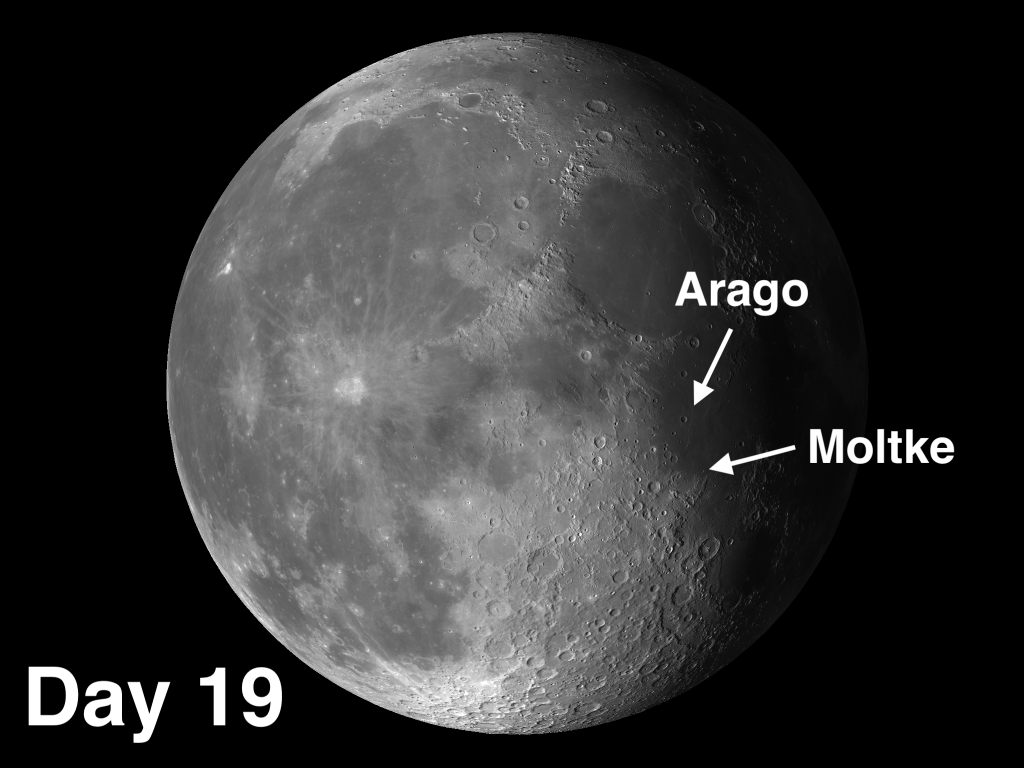 The week of October 9-15 takes us from Day 19 to the end of Day 25. This week we will highlight the craters Moltke (visible late Tuesday evening) and Arago (not viewable until around 2:00 A.M. Wed. morning).
The week of October 9-15 takes us from Day 19 to the end of Day 25. This week we will highlight the craters Moltke (visible late Tuesday evening) and Arago (not viewable until around 2:00 A.M. Wed. morning).
Moltke: [NE/K12] Just south of the Apollo 11 site is Moltke (4 miles in diameter—about 4 arc-seconds), a perfect example of a simple crater with a smooth bowl.1
Arago: [NE/J12] About 50 miles from the western shore of Tranquillity you will find the crater Arago (16 mi.). This is an unusual crater. In the place of a central peak you will see a substantial ridge that extends from the center of Arago’s floor to its northern rim. The evidence suggests that there was a significant collapse of rim material which simply merged with the central peak.
OF ADDITIONAL INTEREST IN SPACE THE WEEK OF OCTOBER 9-15:
Early Sunday morning, for much of North America, you can watch Regulus being occulted by the Moon, or at least emerging from occultation. This event can be viewed from the east coast and much of the western U.S. The west coast will have to miss it.
1There are more simple craters on the Moon than any other type. They are usually less than ten miles in diameter. Simple craters start out with the shape of a round bowl with smooth, circular rims (e.g., Moltke, [SE/K12]). However, some of them develop flat floors resulting from a cascade of boulders which have rolled down the interior walls and settled at the bottom. (Lalande A, Mösting A [SW/K9]).
With patience, good lighting and decent optics, you should be able to tell if a simple crater has a flat or rounded floor by looking at the shadow of the rim as it crosses the center of the floor. The shadow on a bowl-shaped floor will appear as a smooth arc; the shadow falling across a flat floor will be truncated (i.e., the apex will be squared off).
======================
It is highly recommended that you get a copy of Sky and Telescope’s Field Map of the Moon, the very finest Moon map available for use at the telescope. It is available for $10.95 at www.skyandtelescope.com and on Amazon. All features mentioned in this blog will be keyed to the grid on the Field Map and will look like this: Plato: [NW/D9]
Credits:
Courtesy of Gray Photography of Corpus Christi, Texas
Lunar photos: NASA / USGS / BMDO / LROC / ASU / DLR / LOLA / Moon Globe. Used by permission
- Rupes Cauchy: A Best Known Fault on the Moon - July 22, 2024
- Moon Crater Schickard – Crater Floor has Stripes - July 15, 2024
- Moon Craters Langrenus and Vandelinus - July 8, 2024